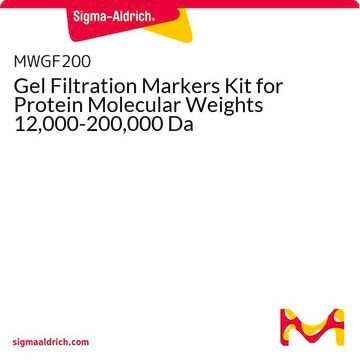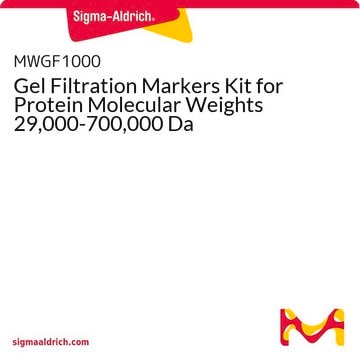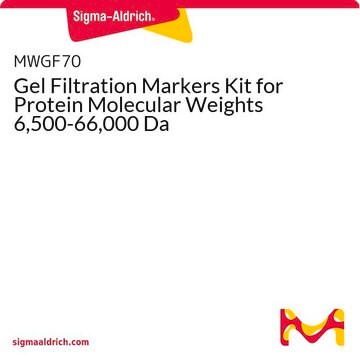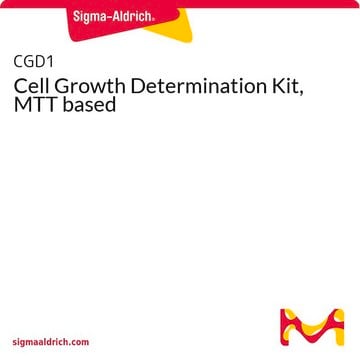D5751
Blue Dextran
Void volume marker for gel filtration columns.
Synonym(s):
Dextran blue from Leuconostoc mesenteroides
Sign Into View Organizational & Contract Pricing
All Photos(2)
About This Item
Recommended Products
biological source
non-animal source
form
powder
quality
200
mol wt
2,000,000
technique(s)
affinity chromatography: suitable
suitability
suitable for GFC marker
Looking for similar products? Visit Product Comparison Guide
General description
Blue Dextran is a soluble derivative of dextran. Its structure includes triazinyl dye Cibacron blue F3GA covalently bound to high molecular weight (2000 kDa) dextran. Blue Dextran is generally used as a marker to determine void volume in gel filtration chromatography columns.
Application
Blue Dextran has been used for calibration of size exclusion chromatography (SEC) column. It has also been used in Dextran blue permeability assays to determine the integrity of co-cultures containing epithelial cells. Blue dextran may be used in affinity chromatography, gel filtration chromatography, protein chromatography, and molecular weight markers. Blue dextran is also suitable to study Alzheimer′s disease.
Preparation Note
Prepared from dextran with an average mol. wt. of 2,000,000.
Analysis Note
degree of substitution: 0.10 to 0.12 mmol Cibracon Blue per gram of dextran
Storage Class Code
11 - Combustible Solids
WGK
WGK 3
Flash Point(F)
Not applicable
Flash Point(C)
Not applicable
Personal Protective Equipment
dust mask type N95 (US), Eyeshields, Gloves
Certificates of Analysis (COA)
Search for Certificates of Analysis (COA) by entering the products Lot/Batch Number. Lot and Batch Numbers can be found on a product’s label following the words ‘Lot’ or ‘Batch’.
Already Own This Product?
Find documentation for the products that you have recently purchased in the Document Library.
Customers Also Viewed
Elementary steps in synaptic transmission revealed by currents through single ion channels.
B Sakmann
Bioscience reports, 12(4), 237-262 (1992-08-01)
Hushan Yuan et al.
Nature protocols, 13(2), 392-412 (2018-01-26)
Feraheme (FH) nanoparticles (NPs) have been used extensively for treatment of iron anemia (due to their slow release of ionic iron in acidic environments). In addition, injected FH NPs are internalized by monocytes and function as MRI biomarkers for the
Osao Adachi et al.
Bioscience, biotechnology, and biochemistry, 74(12), 2438-2444 (2010-12-15)
The membrane fraction of Gluconobacter oxydans IFO 3244, involving membrane-bound quinoprotein quinate dehydrogenase and 3-dehydroquinate dehydratase, was immobilized into Ca-alginate beads. The Ca-alginate-immobilized bacterial membrane catalyzed a sequential reaction of quinate oxidation to 3-dehydroquinate and its spontaneous conversion to 3-dehydroshikimate
Catherine Chiu et al.
Fluids and barriers of the CNS, 9(1), 3-3 (2012-01-25)
Amyloid accumulation in the brain parenchyma is a hallmark of Alzheimer's disease (AD) and is seen in normal aging. Alterations in cerebrospinal fluid (CSF) dynamics are also associated with normal aging and AD. This study analyzed CSF volume, production and
Wenjun Zhang et al.
Analytica chimica acta, 1191, 339358-339358 (2022-01-17)
Size exclusion chromatography (SEC) is one of the most commonly used techniques to detect the molecular weight (MW) of dissolved organic matter (DOM) in aquatic environments. The significant improvement and focus of this method have been the application of multiple
Our team of scientists has experience in all areas of research including Life Science, Material Science, Chemical Synthesis, Chromatography, Analytical and many others.
Contact Technical Service






